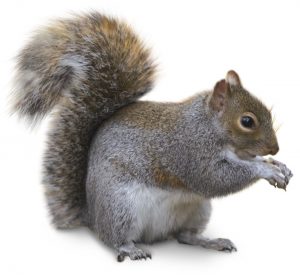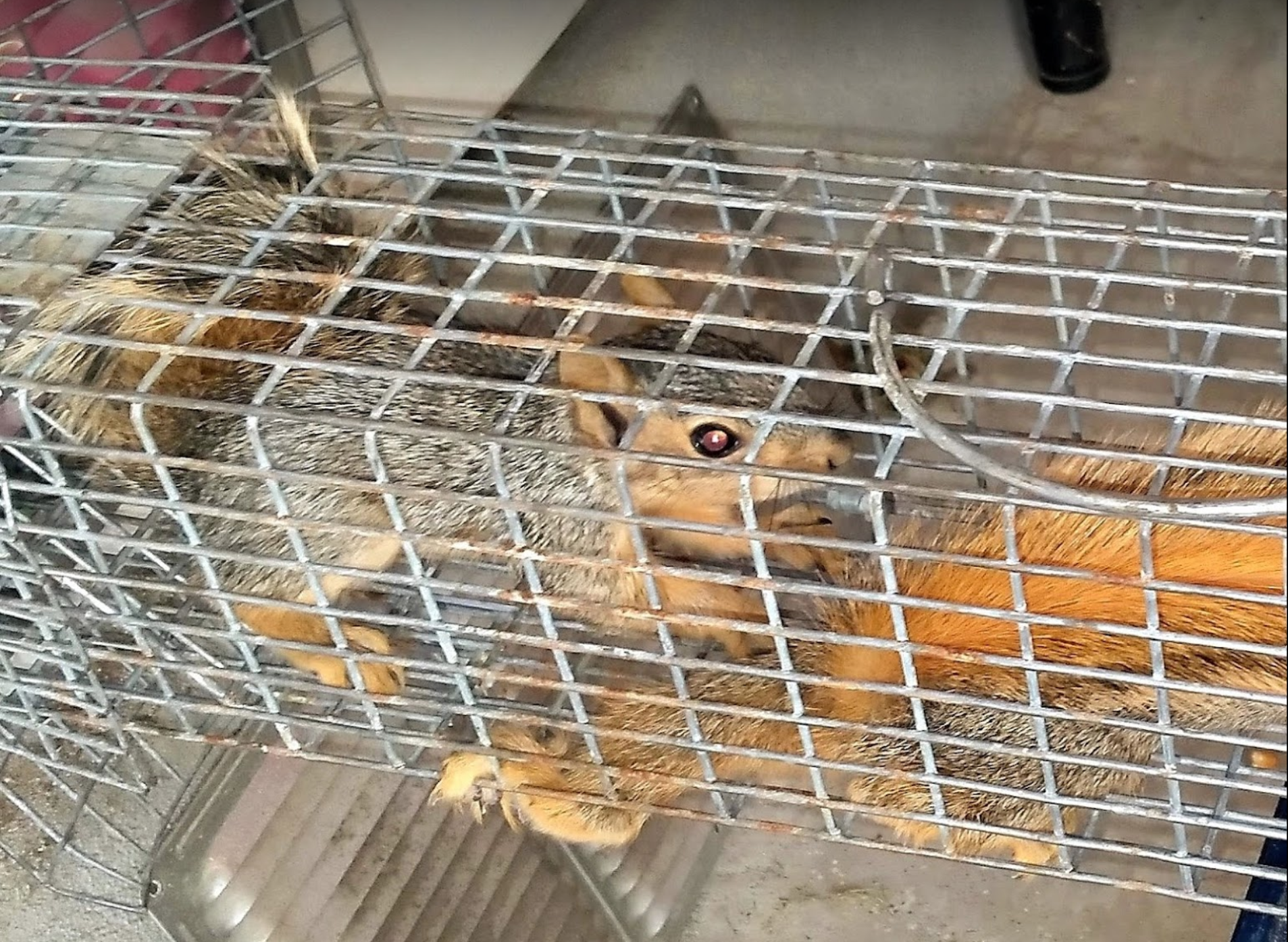Everywhere we go, we see squirrels — they’re a common sight in urban and suburban neighborhoods. But one place you don’t want to see squirrels is in your home. Squirrels slip through tiny openings to get into attics and walls. Once inside, they can wreak all kinds of havoc on your home. They chew, make big messes, and carry parasites and diseases that can be dangerous for your family.
Request Squirrel Removal Services ➔
Learn more about squirrels in the West South Central region and how to tell if you have a squirrel in your house.

What Does a Squirrel Look Like?
There are two common species of squirrels in the area — Eastern Gray and Fox squirrels. While both species have big, dark eyes and bushy tails that curl up behind their bodies, they’re distinguishable by their size and fur color.
The smaller of the two species, Eastern Gray squirrels reach a maximum body length of about 12 inches. Generally, they have short gray-brown fur and white underbellies, though melanistic (all black) individuals are fairly common. Eastern Gray squirrels have largely adapted to the environments they reside in. In noisier, more populated areas, they have learned to communicate primarily through visual indicators rather than compete with other noises.
Fox squirrels are much larger, with a maximum body length of about 28 inches. The fur on their backs is a rusty brown and gray color, and their undersides are typically brownish-orange. Fox squirrels communicate through clucks that sound similar to bird noises.
What Do Squirrels Eat?
Both Eastern Gray and Fox squirrels are mostly herbivores. They eat tree bark, berries, seeds, bulbs, nuts, and other plant materials. Squirrels are scatter-hoarders who store their food in thousands of caches throughout the year. If you have a squirrel infestation in your home, chances are they will store some of their caches in your attic.
How Squirrels Behave
Eastern Gray squirrels are crepuscular — meaning they are most active at dawn and dusk. Fox squirrels are diurnal and active throughout the day.
Both species can give birth twice a year, in late summer and again in late winter. The mothers form nests called dreys in the forks of trees. Their dreys are made out of dry plant materials, including leaves, grasses, and moss. The dreys protect the babies and keep everyone warm. Multiple squirrels may share a drey for added warmth.
When squirrels get into homes, they like to build their dreys in attics and walls. Their litters are born blind without fur. You likely won’t start to hear them until about six weeks later when they can run around on their own.
Noises Squirrels Make
Squirrels are capable of making all kinds of noises. One of the most common sounds they make is a high-pitched chirp. Squirrel noises also range from grunts and barks to squeaks. When they are foraging for food, you’ll often hear them scurrying around and scratching, especially if they are living inside wall voids or in your attic.
Places Squirrels Can Live
In the wild, squirrels typically take up residence in groups of trees or forests where they can look for nuts, seeds, berries, and insects. They create nests or escape into burrows for protection and to raise their young.
Squirrels can also make their way into different areas of your home, including:
- Yard: If you have a lot of trees and underbrush, you’re likely to have several squirrels living in your yard. Things like birdfeeders in your yard will also attract hungry squirrels. You may catch them foraging around for food on the ground or scurrying up and down trees in your yard.
- Chimney: It’s possible for squirrels to enter and nest in metal chimney boxes. This area of your home is appealing because it offers shelter from the elements and a place to stay warm and protected.
- Crawlspace: Your crawlspace is another appealing area of your home for these critters. If there are any cracks in your foundation, squirrels will be able to get inside, using it for shelter or a safe space to store food.
- Attic: Squirrels can also make their way further inside your home. Your attic is a desirable place in your home because it offers a warm place to escape to during the cold months as well as protection when birthing and raising young. They can gain access to your attic in several different ways, ranging from soffits to fascia.
Squirrels vs Rats in Your Home ➔
Frequently Asked Questions
Interested in learning more about our squirrel removal services? Check out a few of our most frequently asked questions.
How Can I Tell if I Have a Squirrel Infestation?
Suspect you may be sharing your home with squirrels? Here are some of the most common signs of squirrels in your house:
- Noises throughout the day: If you hear skittering noises during the day, particularly at dawn and dusk, you likely have squirrels.
- Chewed wiring: When a squirrel gets in your attic, they will chew on everything from wires and plumbing to drywall and stored items.
- Debris in the attic: Squirrels bring in plant materials to build dreys and food to store in caches.
- Chewed entry points: In order to get into your home, squirrels will chew small holes for themselves.
How Do I Know if I Have Squirrels or Rats Living in My Home?
Both squirrels and rats can cause similar sounds and leave behind droppings, which can make it difficult to tell if there is a rat or squirrel in your home. You can differentiate them based on several factors:
- Appearance and noise
- Behavior and activity
- Diet
- Nesting habits
- Tracks and prints
- Squirrel vs. rat droppings
- Damage
Urban Jungle Squirrel Removal Services
Whether you have a squirrel stuck in your attic or squirrels getting in under your roof, you can trust Urban Jungle’s wildlife trapping and removal services to get rid of the squirrels in your house for good. With our exclusion and repair services, our team will fix any chewed wires or entry points to ensure your home is safe and you won’t have any more unwanted visitors.
Squirrels driving you nuts? Start getting rid of squirrels in your house once and for all by contacting us today for squirrel extermination!
Request Squirrel Removal Services ➔


